

Point Lookout Lighthouse
Paul
Sturgis Interview
by Robert Hall
Laura and Robert met with Paul Sturgis, the youngest son of former keeper Zadock Wallace Sturgis. On February 4, 1943, Zadock transferred from Cove Point Lighthouse and served as assistant keeper at Point Lookout under Herman Metivier. On December 1, 1954, Zadock was promoted to keeper and replaced the retiring Herman Metivier. Mr. Sturgis served as keeper until November 30, 1956, when he was forced to retire. We first met Paul Sturgis at the 2004 Point Lookout Lighthouse Open House, and in May of 2005, sat down with him to talk about his memories from the lighthouse
.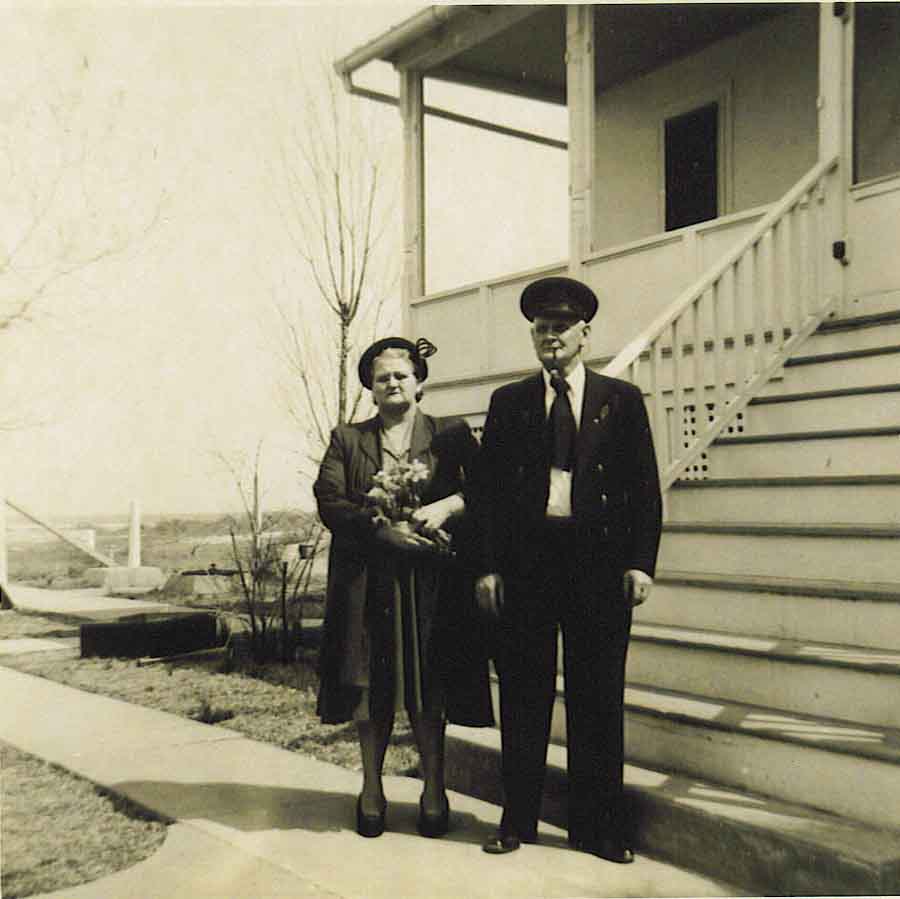
Zadock and Violet Sturgis, on the steps of the lighthouse.
The Sturgis family lived on the north side of the lighthouse, and Paul’s parents slept in the upstairs bedroom that faced the Chesapeake Bay. The oldest son, Wally, had the small bedroom to himself, and brothers Jack and Paul shared the upstairs bedroom that faces the Potomac. Herman Metivier and his family lived on the south side of the lighthouse and were very religious; Mrs. Metivier could tell you anything about the bible that you wanted to know.
Everyone enjoyed the visits from the buoy tenders: the Mistletoe, the Balberia and the Wisteria. Paul’s mother always knew where to find him when the buoy tenders were at the dock, as he enjoyed hanging out with the guys on the ships. When the men on the boats would shine a bright light over the side of the boat, the crabs would be drawn to the light. The crabs were so plentiful that the men just scooped up the big ones, easily catching a bushel within a half hour.
Paul remembers all the work that the buoys required. The buoys would arrive on tenders and would be offloaded onto the pier. The workers used the hook to load the buoys onto a trolley car, and then the buoys rode the rails and were unloaded behind the shed to dry out. Once the buoys had dried out, they were scraped using a scraper and a lot of “elbow grease”. The buoys were then repainted and stored in the shed until the paint dried. Finally, the buoys would be loaded back onto the tenders to be returned to service.
Growing up, Paul didn’t have a lot of friends, since most folks lived 6 miles away from the lighthouse. Due to the long distance, bike riding was very popular. Paul did get to make a special trip to Washington, D.C. Joe McQue was from Washington, D.C. and often visited the point to go swimming and soon befriended the Sturgis family. One weekend, Paul went to stay with Mr. McQue in Washington. His parents put him on the bus at the Point Lookout Hotel, and sent him on his way, with strict instructions to the driver to not let the boy leave the bus until it arrived in D.C. Mr. McQue showed Paul the city and bought him a cowboy outfit, complete with Hop Along Cassidy pistols. Paul also had a Lionel train set when he was at the lighthouse, the kind that used tablets to blow smoke out the smokestack
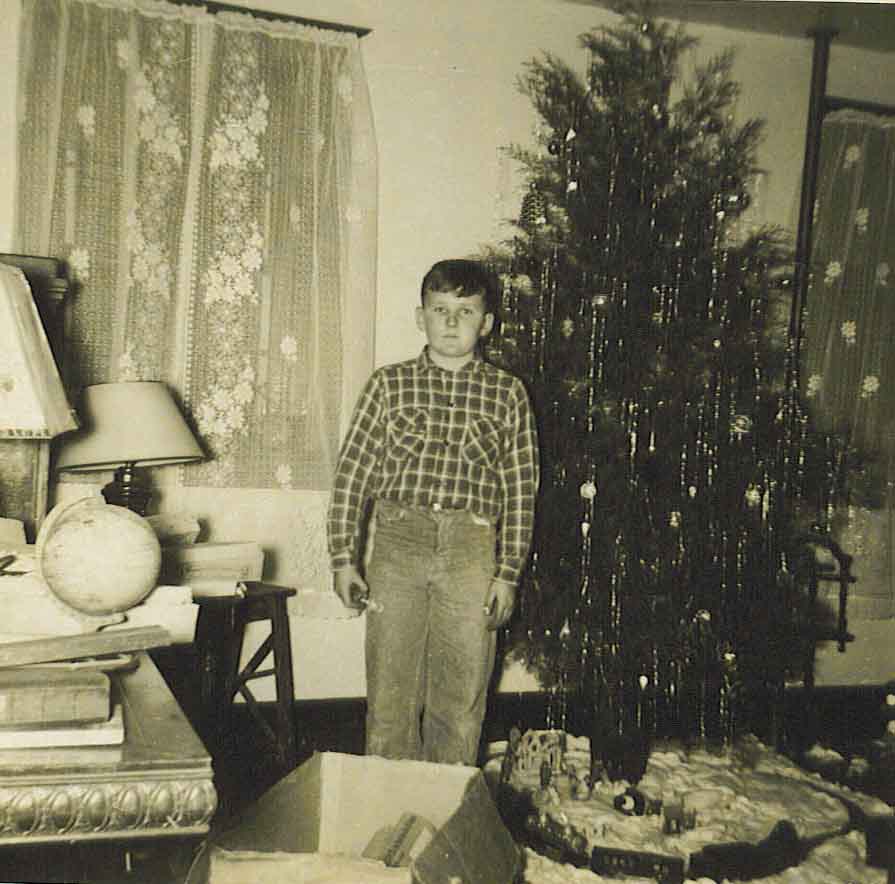 |
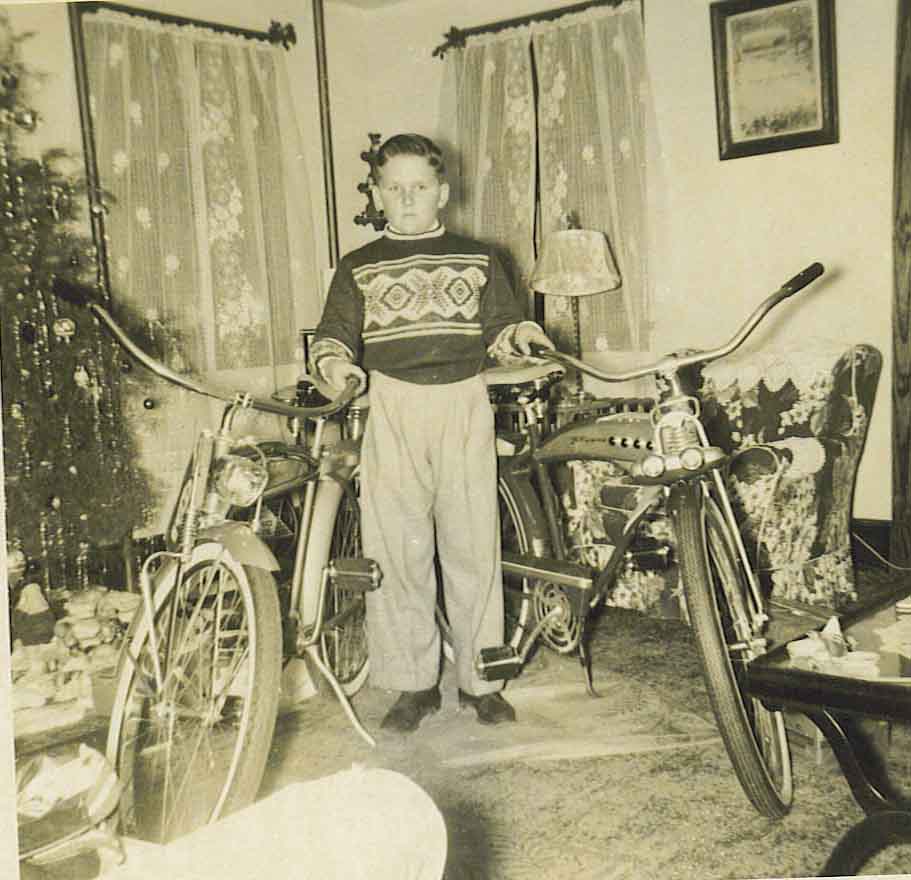 |
| Christmas Tree, with train. | Paul with a Christmas Present. |
Growing up, the Sturgis boys seemed to get into
everything, and were in trouble a lot. Paul
and Jack would play with the trolley that moved the buoys, and invariably the
trolley would jump the track and land Paul and Jack in hot water with their Dad.
When Paul was 8, he caught the marsh grass on fire.
The fire quickly got out of control, and spread to the old cedar buoys
beside the pier; the fire pump was on the pier and the men had to go by the fire
to get to the fire pump!
The men had to get to the pump quickly in order to put out the fire. Mr. Sturgis came looking for Paul; Paul thought he was safely hidden
away, but his father quickly proved him wrong. One time when Paul’s parents were away, he snuck into their bedroom and
examined a pistol that he had been curious about for a long time.
Not wanting to get caught, Paul took the screen out of the window and
fired a shot into the air. Unfortunately,
Paul was a much better shot than he ever imagined, and he hit the electric line.
Much to his horror, the top electric line was severed and landed in the
yard. He quickly replaced the
pistol and left his parent’s bedroom; the electric line was repaired without
anyone ever suspecting what had happened.
There used to be an old sign about 100 feet off shore that said: “Cable
Crossing Do Not Anchor”. The boys made a sling and would search for the
perfect rock to hurl at the sign. They would aim for the “A” in
anchor.
Paul used to hide in the attic area at the top of the cupola stairs to
avoid getting in trouble. The cistern was not in use at that time, and water was
supplied by the well. The Navy
Department built a wooden frame on the point (the land used to curve out near
where the current buoy is today). The
frame consisted of 3 layers of trees that were tied together.
The Navy would use the structure for target practice, shooting 50 caliber
shells from airplanes. Of
course when Paul noticed that some shells landed in the yard, he immediately
went out to collect them and soon discovered they were so hot that they almost
burned his hand. The
Coast Guard soon made the Navy stop this target practice because of the danger
to the lighthouse and its occupants. Paul walked the beaches and collected Civil War relics and items that
were discarded from ships that came in and out of the Chesapeake Bay.
Not everything the boys did involved mischief. One time, Paul was playing softball and reached into a tree to retrieve the ball. Unfortunately, he put his hand into a nest of yellow jackets and was stung multiple times. His father put chewing tobacco on the stings to soothe the burning. Paul helped out with garden but didn’t like it; he hated weeding. In fact, to this day, Paul won’t have a garden. As a child, Paul had paralysis of the face (Bell’s Palsey). Mr. Sturgis had to massage Paul’s face under a heat lamp for 2 hours a day. Paul had to wear a home-made hook that extended from the corner of his mouth to his ear, which resulted in cruel remarks from the other kids. The doctor said that Paul was one of the lucky ones that would completely recover from Bell’s Palsey.
Swimming was a big part of life at the point, however, there were only about 2 months of good swimming because of the pesky jellyfish that still plague the watershed. The boys would jump into the water off the pier and pilings into about 16 feet of water at the end of the pier but closer to 10 feet near the ladder. One day, Paul was standing on the pier next to his father, while his two older brothers were in the water. Paul's father said: "Boys watch him" and with that, his father threw Paul off the pier. Paul said when he hit the water he went under and thought he would not get back to the top, but he came up swimming. At the mouth of the Potomac River, there was a whirlpool that would twirl and would sometimes drop about two feet in the middle. In the late 1940s, a young Olympic swimmer visited the point and asked Mr. Sturgis if she could practice in the waters off the lighthouse. He informed her that she could not practice on government property and warned her about the swift currents and dangerous conditions. He even told her about the whirlpool that appeared at the end of the point. Unfortunately, the young girl did not take his advice and drowned in the treacherous waters; her body was found a week later and it was not a pretty site. Paul was supposed to stay away until the body was removed, but he couldn’t resist and viewed the badly decomposed corpse.
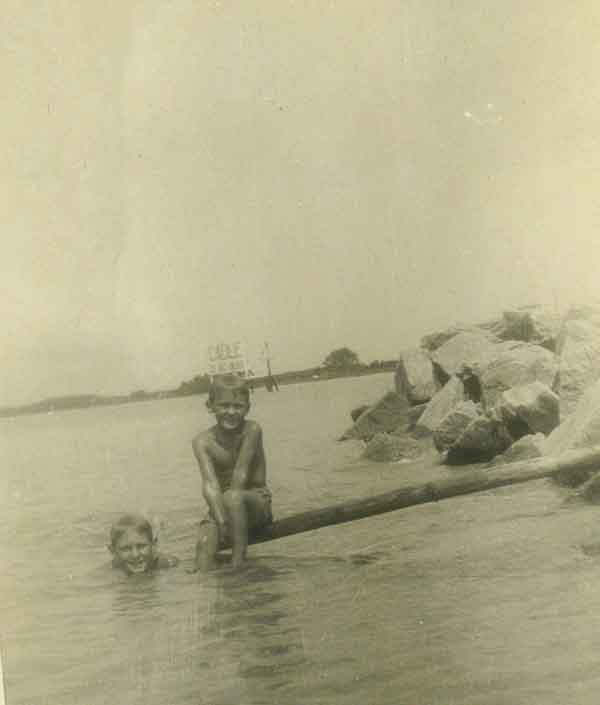 |
|
Swimming at the Point. |
Paul spent many hours in the radio room with his father,
who sometimes let Paul talk on the radio, even though that was against official
Coast Guard Policy. The call
letters for the lighthouse were NMN33 (Nan Mike Nan 3 3). Point Lookout would often communicate with
headquarters in Norfolk (call letters MNM).
During World War Two, all keepers on the Bay had to watch ships going up
the Chesapeake and were required to identify and log the activity twenty four
hours a day. If a ship could
not be identified, then the keeper had to call Norfolk. Paul would help with other official duties, such as
covering the fresnel lens during the daytime.
Due to the high power magnifying properties of the lens, the concern was
that a fire could be started in the marshy areas if the lens were not covered. Additional Coast Guard personnel were stationed at the point and lived in
the barracks, (inside the building that housed the radio shack). The men would help work on the buoys, but oftentimes the men would be
reassigned, and would disappear from the point.
|
|
|
Lighthouse Guys. Zadock Sturgis is third from the left. |
Even with the advent of electricity, the lighthouse was not completely maintenance free. For example, the lighthouse was heated by a coal furnace which required a lot of attention throughout the day. The furnace had to be "shook down" in order to remove the ashes, and coal had to be hand carried through the north side basement access door to keep the fire going. In order to keep the lighthouse warm, 2 buckets of coal had to be pitched into the furnace two to three times a day. The coal furnace was very efficient and would make the house so warm that it would “run you out”. No retaining wall existed around the furnace to protect it from water, and when the basement flooded the water would put out the fire in the furnace. No circulating pump existed, so every year, they would have to bleed the air out of the pipes to ensure the natural circulation of the water to the radiators. The ashes were hauled to the driveway so you wouldn’t get stuck in the sand. During Nor’Easters and Hurricane Hazel, Paul swam in the flooded basement, which had several feet of water. When asked if he was afraid of the electricity, Paul laughed and said that he never thought about it at the time. During heavy flooding, the kids had to take a rowboat to the causeway to catch the school bus.
A chicken house existed behind the barn and Paul spent many hours breaking oyster shells with a copper head mallet. The chickens would eat the oyster shell pieces to assist with eggshell production. There was a cow named Betsy that lifted Paul to the loft. There was also a gigantic fig tree that was 40 foot tall and 80’ in diameter. In the late 1940s, the Navy installed a radar building just south of the smokehouse. The radar station had wires running everywhere and emitted the strangest ringing noise, which took years for Paul to forget. Francis Nevins and Paul’s parents reopened the church across from Ridge School. During a homecoming trip, Paul and his wife Bonnie tried to visit the church but the services were over by 9 am.
The engine room, located at the end of the middle shed, had two compressors and a generator. One air tank was 8 feet in diameter and 12 feet tall. One hundred twenty pounds of air pressure was required in order to make the horn work. One day, Paul was behind the fog tower and without warning, the horn sounded a single blast. All the men at the station came to inspect the horn and when they found Paul there, immediately blamed him for the blast. However, there wasn’t any pressure in the tanks, so it was impossible that the horn had sounded; since no one could explain how the horn had sounded, the topic was dropped. Perhaps there was just enough air in the tank for one more blast, but that seems unlikely. There was also another unusual occurrence with the fog bell. For some reason, the bell would sometimes ring one time after the clock mechanism had been thru a complete cycle. One day, Paul’s father was standing by the fog bell and happened to notice that the tower had settled just enough to allow the stop to be misaligned; when vibration or a slight breeze would move the stop, it would fall one more notch, causing the bell to ring, seemingly on its own. Other than the mysterious fog horn, nothing unusual happened during his time at the lighthouse. Paul played outside night and day -including the prison and Fort Lincoln- and never saw anything or heard anything strange other than the foghorn incident.
A number of tragic events occurred at the point, including numerous boat wrecks that caused the keepers to provide assistance. Paul admired Mr. Metivier and would help him out around the lighthouse. One time, the pair helped to float a grounded sailboat. Paul followed Mr. Metivier’s steering instructions, however, the anchor went right through the stern! The Coast Guard was not happy with the damage and took the boat away from the lighthouse. Another tragic event occurred while Paul was riding the bus to school. As the bus rounded the curve in Wynn, the boy next to him looked up at the plane overhead and said “that’s probably my Dad’s plane”. As the boys watched, the Glowmaster Plane exploded and 5 parachutes floated down to the water and it appeared that all the men were safe. Paul would later learn that all the men perished and were in fact decapitated. Of the eight helmets, one was cut completely in half, so the men never stood a chance. When Paul returned home from school that afternoon, the Navy was recovering the debris and bodies. He doesn’t know how that boy ever lived with the memory of watching his father die in such a horrible manner.
Some of the local guys used to build boats that were faster than the marine police, so they could outrun them. These men would sometimes get drunk on the Eastern Shore and then head their boats back toward the lighthouse. One guy got so drunk that he mistakenly beached his boat completely on shore- so far on shore that you could walk all the way around the boat! The man became very angry and ended up accidentally shooting one of his friends in the leg. The police arrested the man with the gun, and the friend recovered.
The family had many dogs, including Chesapeake Bay Retrievers. One dog was named Fuss Budget. She had 13 puppies but unfortunately decided to birth them in the coal bin. When a coal supply truck brought additional coal, Fuss Budget was killed trying to protect her pups. The boys nursed the puppies on milk by using a bottle and nipple until the puppies were old enough to be given away.
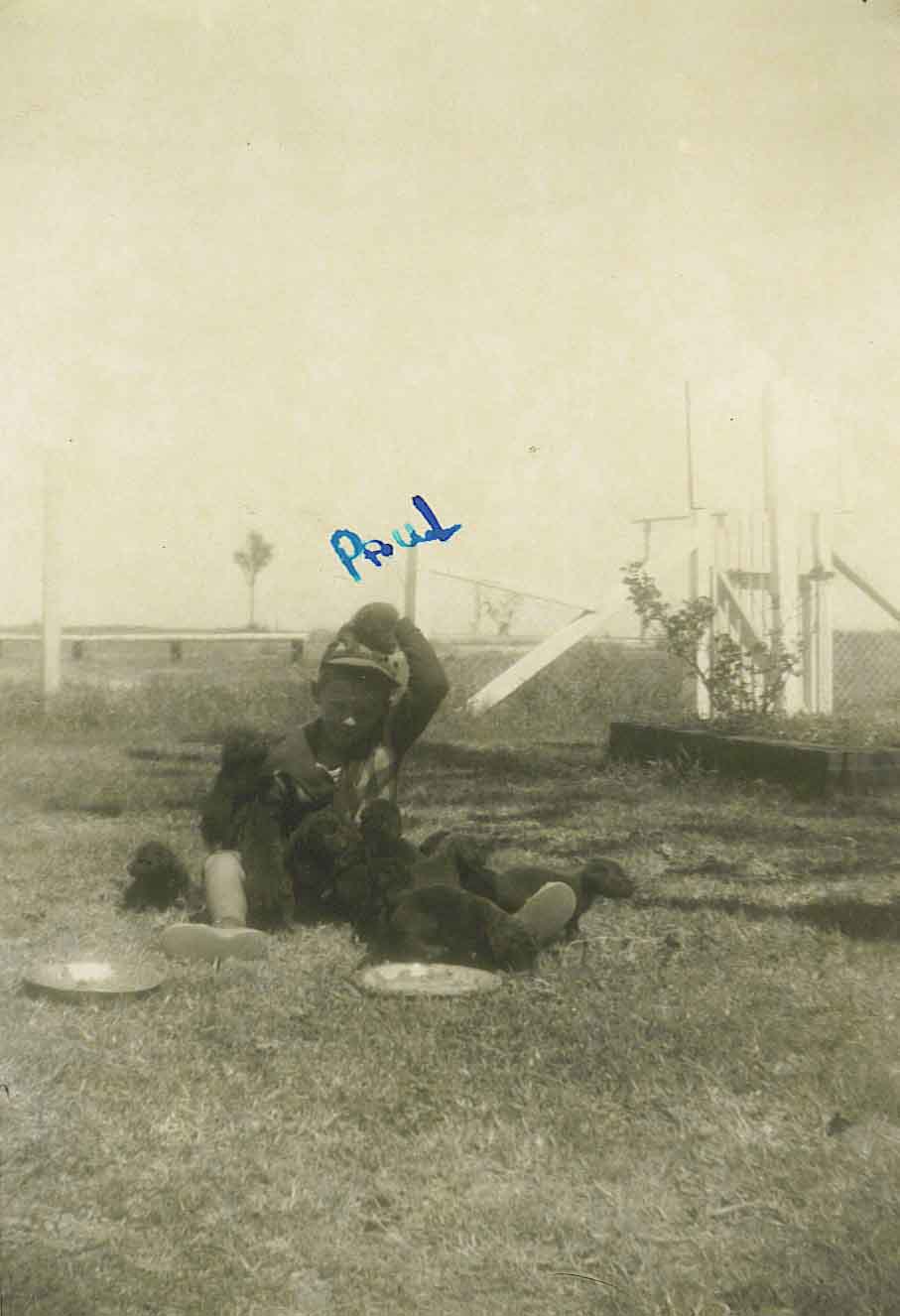 |
|
|
| Paul with Fuss Budget's Puppies |
|
|
| Paul Sturgis, Dagwood and Fussy Budget on the lighthouse steps. |
There were many activities to enjoy at the point with friends and family, such as fishing, crabbing, family dinners and corn shucking parties. The only radio show Paul liked was Cincinnati One Ohio, however, the show wasn’t on in summer, so they had to be creative and make their own fun. To pass the time, the men folk would sit on the swing and try to spin the tallest tale possible, each one trying to outdo the other. The men had great imaginations, and some of the greatest stories ever told were created on that swing. Paul spent many hours exploring the grounds around the lighthouse, and while he knew about the prison camp, he was surprised that the local men never talked about the Civil War hospital, which was located just outside the gate of the lighthouse. A lot of people remembered how the war came to Southern Maryland, but none ever talked about the hospital. During the war, water moccasins were caught and placed in the moat around the fort to discourage prisoners from entering. His father would sometimes visit the local bar in Ridge, Fiends, to visit with friends and have a beer. Paul was a little tyke, so the men would pick him up so he could pull the arm on the “one armed bandits”. (Slot machines were popular in Southern Maryland until the 1960s when they were outlawed.)
Paul lived at Point Lookout from the time he was 9 months old until he was fifteen and a half. Unfortunately, his father was diagnosed with heart problems, but the Coast Guard did not tell Mr. Sturgis; his service was short of the requirement for full retirement when the Coast Guard forced him to out. He was also ineligible for Social Security, since he could choose either the Coast Guard retirement or the Social Security, but not both. Unfortunately, the Coast Guard retirement didn’t provide enough money to finish raising the family’s youngest son Paul. After Mr. Sturgis retired in 1956, the family moved to Ocean City, Maryland. Paul considered himself spoiled because he got to drive the family car to school everyday. However, he had to pay for the gas as well as all his school supplies, working nights and weekends to support himself.
Mr. Sturgis could almost always been seen with a pipe in his mouth. He had false teeth, and when he took his teeth out he could stretch out his chin and touch his nose. He suffered from health issues after he retired from Point Lookout, including a heart attack a few years after he retired. In 1973, he succumbed to a second fatal heart attack. Jack would check on his father very night at 11 pm by phone, because his Dad was sure to be watching the 11 o’clock news. On October 11, 1973, Mr. Sturgis didn’t answer the phone. Jack drove to his father’s house and discovered him on the floor next to his bed. Paul and Bonnie placed a footstone on Mr. Sturgis’ grave that has a lighthouse image on it, in honor of his many years of service in lighthouses. Paul believes that his father would have been better off if he hadn’t been put out to pasture by the Coast Guard.
Paul’s mother, Violet Sturgis, predeceased her husband by 4 years. Mrs. Sturgis was born on April 21, 1908 and while at the lighthouse, she did all the washing and ironing in the basement, including uniforms. She was of a small stature, about 5’4 and later in life became severely overweight. She wasn’t supposed to have any additional children, so when Paul was born, she went to Johns Hopkins in Baltimore in case there were any problems. In 1969, she had surgery for a pancreatic cyst, however, she hemorrhaged after the surgery and passed away in the hospital.
Paul’s oldest brother Wally joined
the army as a paratrooper. He
had a big jump in Texas and injured both ankles.
Later, he joined the Military Police and then went into guided missile
systems. Wally retired as a
Lieutenant Colonel and passed away in August 1995.
His brother Jack lives in Snow Hill Maryland. The siblings had an older brother named Bobby, who died at 9 months of
age.
|
|
|
Wally, Paul and Jack Sturgis,
working in the garden. |
Many things have disappeared from the area around the lighthouse, including the actual point! The steel bulkhead is all rusted away and many other buildings have disappeared, including the Point Lookout Hotel, the barn, and the chicken coup. Paul remembers a few people that worked at the lighthouse, but hasn’t kept in touch with them over the years (many have undoubtedly passed away by now). He didn’t remember the windmill, however the cement anchoring platforms still exist.
During his visit in 2004, Paul walked the beach and showed a friend where he found the civil war bullet that he had given to her from his childhood collection. Paul and his wife Bonnie had dinner at a restaurant in Wynn and thoroughly enjoyed it. Paul lamented that he never thought in his wildest dreams that the government would replace the lighthouse. Paul has visited the lighthouse several times over the years, but 2004 was the first time he was able to return to his childhood home.
|
|
|
Paul and Bonnie Sturgis, May 2005. |
Many
thanks to Paul and Bonnie Sturgis for sharing
their childhood experiences and pictures with
us.